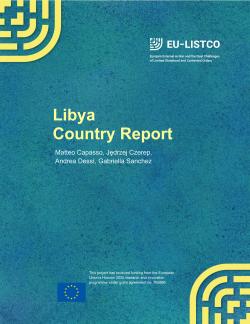Libya Country Report
This study on Libya is one of a series of reports prepared within the framework of the EU-LISTCO project, funded under the EU’s Horizon 2020 programme. Libya is a special case within the EU-LISTCO project. It is in the western region of North Africa, bordered by the Mediterranean Sea to the north, Algeria and Tunisia to the west, Chad and Niger to the south, Sudan to the south-east and Egypt to the east. The security and stability of Libya is fundamental for the economic and political future of Europe, particularly in relation to migration, radicalisation and political economy. Because of the NATO-led intervention that brought about the collapse of the Libyan Arab al-Jamahiriyah, the country has now entered an interrelated social, economic and political crisis, and violence has been simmering for the past eight years. While the collapse of the previous government has been beneficial for some, numerous armed political actors now control the Libyan territory, supported and funded by external powers that often have contradictory political agendas. The purpose of this report is to answer the following research questions: what is the background of areas of limited statehood and contested order in Libya?; how and when can areas of limited statehood and contested order in Libya turn into governance breakdown and/or violent conflict, and how can these threats affect the security of the EU?; what are the resilience mechanisms in Libya?
-
Details
(with Matteo Capasso, Jędrzej Czerep, Gabriella Sanchez) EU-LISTCO, December 2019, 51 p.
1. Introduction
2. Eu-LISTCO Conceptual Framework
3. Background on Areas of Limited Statehood and Contested Order
3.1 Contested Order
3.2 Areas of Limited Statehood
4. Risks and Tipping Points
4.1 The territorial level
4.1.1 Tripoli
4.1.2 The South: Fezzan
4.1.3 Eastern Libya: a LNA Stronghold?
4.2 The Sectoral Level
4.2.1 Political Economy
4.2.2 Radicalization
4.2.3 Migration
5. The Role of External Actors
5.1 International Organizations
5.2 African Neighbours
5.3 Russia
6. Resilience Mechanisms
6.1 Social Trust
6.2 Empirical Legitimacy
6.3 Institutional Design
7. Conclusion
References



